Marmolada Bees

Neal Beggs / Shipsides and Beggs. Pen, colour, notebook. 2010
1
The presence of a lightening storm can be detected by fast moving, dense clouds above; a tingling sensation in the skin; the feeling that your hair is standing on end and by the buzzing of metal equipment. (Outdoor Survival Manual, G Hattingh, 2001)
Neal: "My own initial memory was of a strong fear of a second deadly strike immediately following the first. Prompting a very basic desire to get-the-fuck fast away from the aerial! With the cameras active and all our metal gear I figured we were easy targets. The theory that the aerial would protect us, as it did in the first strike, was not a guarantee in my mind of safety from a second strike.
I figure we were fortunate to get away from the aerial unscathed. So the first strike was definitely very frightening, and kicked in that basic 'run!' instinct, keeping the fear to a manageable level, even though it had crossed well into the 'red'. Of course the winter room (a small room that is always open in a mountain refuge) helped a lot in calming things down. In there we had company and could brew-up, collect our thoughts and prepare for our descent in a calm manner.
During our descent attached to the wire (the song 'like a bird on a wire' did enter my head at the time) it was of course very tense, sitting there waiting and paying out rope - while the lighting cracked around us. But the job at hand was to get down and this helped a lot in focusing the mind, every meter descended was one meter closer to getting off the wire and out of the strike zone. The fear was nowhere near as strong as at the time of the first strike on the summit. If the lightning struck, we wouldn't know it, so in a strange way this had a calming effect.
The glacier, which had always been my prime worry due to crevasse and avalanche, was of course no problem.
Seeing the lighting open up about 50 meters to Dan's right and behind him (from my view point) was shocking and in slow motion. First it was a buzzing horizontal line without any definite form, then expanded from the center, and suddenly struck out side ways in an electric yellow/blue/white plasma way, toward Dan. It was nothing like the typical forked lightning we often see from afar, or I once saw hit an electrical transformer 50 meters from me in a mountain village some years back. No, this strike had a spooky feel about it.
I'm sure this is not an accurate description of the strike but more an after glow. The impression of something bright that burned itself onto my retina for a split second has been distorted by time and translated into something recognizable. Mixed up with a thousand different visual references (take a look at my sketch above). Strangely no flash or bright light was picked up by the camera as I was filming Dan at the time of the strike suggesting a little mental invention on my part between what I saw off to my right and what the camera saw pointing dead ahead. Surely at some point something bright should have entered the screen from the right, but no, nothing. Just a loud crack! Followed by an abrupt diversion of the camera toward the ground and shouts of "run get away from there"! The whole clip has the feeling of a home movie shot just at the moment a car bomb explodes close by but off screen. There's a loud bang followed by jerky footage of ground, shoes, and panic, but no sense of what actually happened. I guess this is as close as we'll get to a sense of the war that was fought on this mountain in 1916."
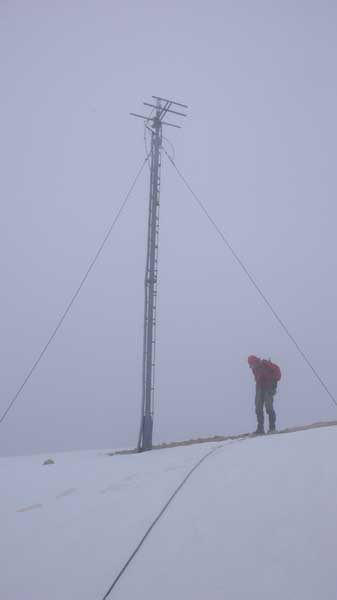 2
2
Dan: "It was quite weird actually lots of things happened at once just at the moment we got onto the summit the ice axes and my spectacle arms buzzing and the metal Via Ferrata (*see below) wire on the summit ridge. Stupid we didn't think it through I guess tiredness and happy to be at the top. I went to the space under the triangulation of the conductor aerial mast to film Neal coming up the last bit. As I got there I looked at the ladder prongs up the mast and had a crazy thought was to climb them (to be really as high on the mountain as you could be) something kept me from doing that .ha ha that would have been a mistake ..phew!
As soon as I got under the mast my camera died as the battery packed in - no power! I quickly opened the back to change it and just at that moment the loudest crack, like a horse whip came from just behind me. I didn't see anything as my focus was on the camera battery. But knew what it was straight away and that it was very close.
We ran luckily we were calm enough to run in line so the rope between us didn't touch the mast or its supports or get tangled. I then saw Jean Paul (of the climbing couple we met earlier on the ridge and on the via ferrata wire) beyond the bivi hut to the left he was obviously running from the iron cross further on the summit ridge (his own close call).
In the hut was lovely a tiny space quite cosy with a couple of rough bunks we made coffee and shared food with Jean Paul and Irene and expressed our excitement and relief. We decided to wait a while and then descend together.
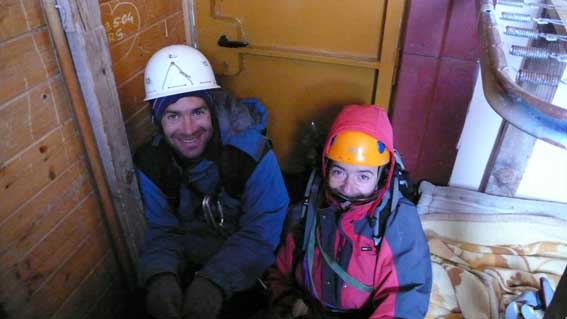
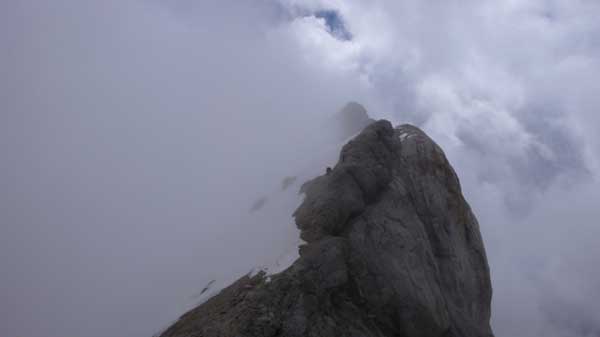
3 / 4
I thought then that we were lucky that the lightening only started when we were on the very top and not when were exposed on the ridge shuffling up the metal via ferrata wire. It was funny that it went just as I stepped under the mast and not before what an astounding sequence of events! - starting at 5am our journey to the summit around 1pm. It was as if it was waiting for us.
The descent was also a little scary for a while because of the via ferrata wire there. There was no choice but to use it as the heavy falling snow made down climbing pretty impossible and our first priority was to get off the exposed snow curve. So the first section of wire was scary imagine four people linked with wet ropes attached to a metal wire descending from the top of a mountain in an electric storm .). I was relieved every time we heard the crack of lightening as it mean it hadn't hit the wire. I was glad to get off it then it was a little less nervy. Wherever I could, when static belaying Neal, I unclipped the metal karabiners from the wire and anchored on with fabric slings. From here I started to enjoy dropping down the wire at speed and dealing with the more logical and methodical worries of anchors and belays.
The glacier was fine a little spooky though as visibility was zero at times and the slope hard to judge.
The drawings seem to have flown out since then my pen might still be electrified."
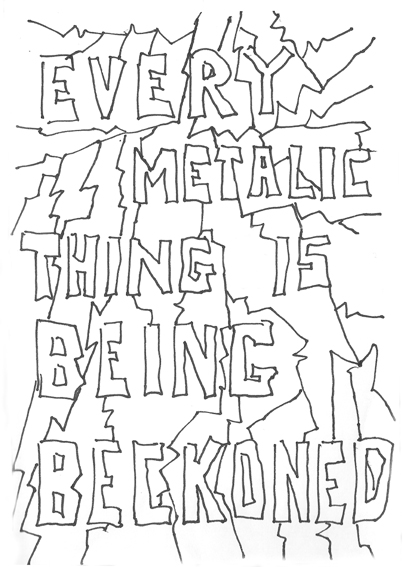 5
5
Dan Shipsides / Shipsides and Beggs. Pen, notebook. 2010
Hi Irene and Jean-Paul!
Hope you enjoyed the rest of your climbing holiday.
It was great to meet you on the summit of Marmolada under the lightening!
We have lots of fantastic photo's and video from our trip - some of which you are in. I attach one of you coming up the small glacier behind us - before the sun went away...
 6
6
Neal and I have been thinking about the lightening and wondering how to use the experience artistically (we are both artists who often work together).
I'd be fascinated to hear from you how you felt the experience was in words (french or spanish or english) or even drawings. Could you describe it? - or recount the time from getting to the top, spending time in the hut then coming down together.
I made a little drawing "Every Metalic Thing is Being Beckoned" - as we got near the top all the metal things we had with us began to buzz.
For me it was fun - but a little scary being on the wire coming down.
Would be lovely to hear from you.
Best wishes,
Dan
Hi!
we have problems with internet at home. it was great but at the same time a little bite scary. jean paul was at the cross in the summit and the bees was getting around the cross. he didn't touched it and he comes runnning to us. The hair was electrified and when we were going down to the glacier, in the via ferrata, the mosquetons were also electrified and i dropped down for avoiding the bees in my hands.
If internet it's ok i will send you our photos. i'm at work. i'll send you later.
the rest of our holidays was in National Park of Ecrins . we have climbed la Meije and in the refuge was our friend and it was surprised.
we are in contact, sorry but i'm working and we still have had no time to see the photos.
thank you for remember us to write you. Have a nice day and if you are going to Toulouse , you can visit us.
bye and take care
Irene
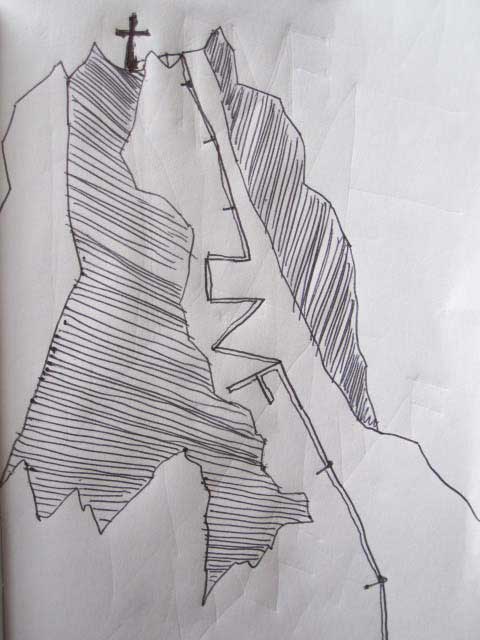
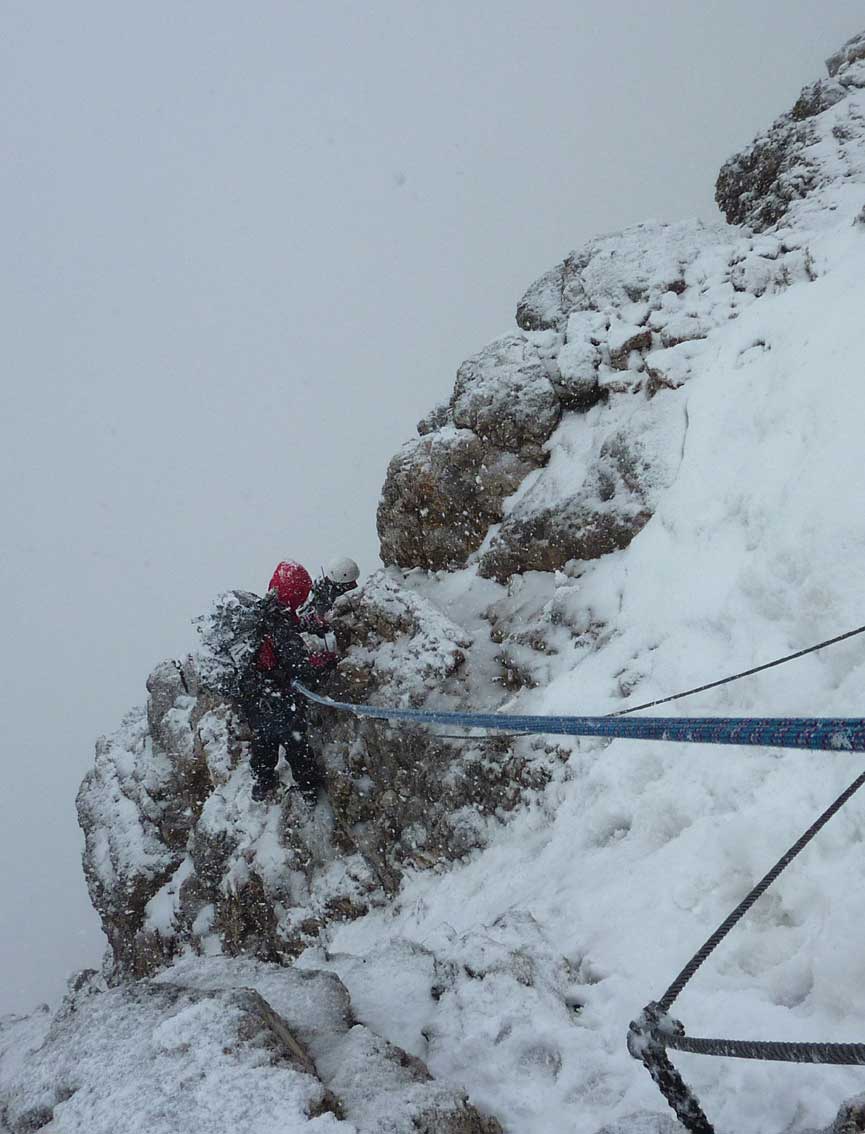
7 / 8
* Via Ferrata ( Iron Way ) is a form of aided climbing developed during WW1 to move troops into high and precipitous mountain locations. During the war years the Alps featured heavily as a battleground and contributed significantly to the mythologies of warfare and nationhood. Via Ferrata routes are found in strategic locations along still, with the debris of war barbed wire, trenches, bunkers and craters.
Images 1,2,3,4,5,6,7 courtesy of Shipsides and Beggs 2010. Image 8 courtesy of Irene and Jean Paul.